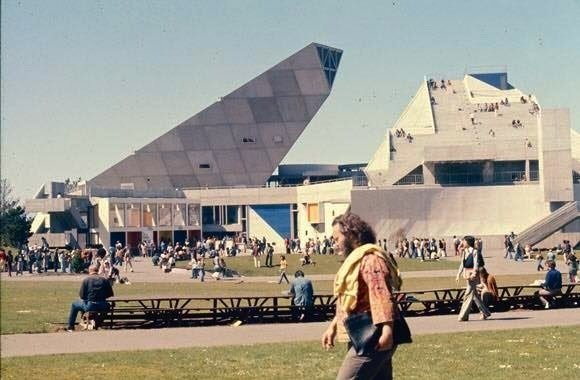Remembering Paffard Keatinge-Clay (1926-2023)
It is with great sadness that we announce the passing of Paffard Keatinge-Clay, architect of several Modernist buildings in California from the 1960s and 70s. Keatinge-Clay passed away on March 17, 2023 at the age of 97 in Mijas, Spain, where he had been living since leaving San Francisco in the mid-1970s. Those who have followed Docomomo US/Northern California might remember the tour of the San Francisco State University (SFSU) Student Union that he gave himself to our members in 2006. He was the design architect of this outstanding example of Brutalist, modern architecture, and it was an honor to have him guide us.
Keatinge-Clay was one of the last living architects who had the privilege of working personally with some of the most renowned Modernist architects, including Le Corbusier, Frank Lloyd Wright, and Mies van der Rohe. Born in England in 1926, Keatinge-Clay was educated at London’s Architectural Association School of Architecture (AA) and ETH Zurich before migrating to the United States to study under Frank Lloyd Wright at Taliesin. He then worked for SOM (first in Chicago, then in San Francisco) before he opened his own office in San Francisco’s North Beach in 1963.
San Francisco is fortunate to have several of Paffard Keatinge-Clay’s few built works, in which he synthesized the essence of his Modernist architectural training with his own, uncompromising language. In addition to the SFSU Student Center (1975), his other realized works include an addition to the San Francisco Art Institute on Chestnut Street (1970, currently vacated), the French Hospital on Geary Boulevard and 5th Ave (1968, now Kaiser French Campus). His own residence, known as Mount Tamalpais Pavilion, in Mill Valley (1965), should not be missing from any book on ‘The Architect's House.’ After leaving California for Spain in 1975, Keatinge-Clay continued to teach while also creating sculptures, artwork, and theater plays.
Despite working outside of the prevalent regionalist schools of architectural thought in the Bay Area at that time, and often beyond viable project budgets, Keatinge-Clay remained steadfast in his commitment to devoutly Modernist language and uncompromising execution of his built works. His Mill Valley residence is likely one of few pre-stressed concrete residences in California. His work with exposed concrete, a tribute to his time with Corbusier, is among the best in San Francisco.
With his brief time in California and limited output, he might have been all but forgotten if admiring architects had not kept his name and work alive by inviting him to lecture the next generation. Lectures at USC, Sci-Arc and AA are a true testament to his remarkable talent and artistic vision, and show his respect for and lessons learned from working with the other greats of the Modern Movement. Eric Keune’s (Docomomo US National Board Member) superb monograph Paffard Keatinge-Clay, Modern Architecture/Modern Masters (Sci-Arc Press 2006) has a full, illustrated listing of Keatinge-Clay’s architectural and artistic work.
To honor Keatinge-Clay’s contributions to Modern architecture, Docomomo US/NOCA will offer tours of the SFSU Student Union -- stay tuned for details. We will continue to inform the public of the importance of the San Francisco Art Institute and advocate for its documentation and preservation in the face of a currently uncertain future.
The SFSU Student Center (1600 Holloway Ave.) is open for the public to visit, including Saturdays until 4pm. The lower floor offers a small interpretive display about the building. With some luck, the cathedral-worthy portal doors with their Corbusier-inspired artwork will be open for you.
Paffard Keatinge-Clay's legacy will always be remembered and appreciated by those who knew him and his work, and continues to inspire burgeoning architects.
Paffard Keatinge-Clay walks through the SFAI addition.





